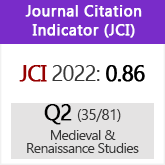Calatrava. Una villa en la frontera castellano-andalusí del siglo XII
DOI:
https://doi.org/10.3989/aem.2000.v30.i2.478Abstract
The aim of this article is to analyze the complex reality of frontier towns through a significant example: the town of Calatrava in the 12th century. The study starts with the incorporation of Calatrava and its area into te kingdom of Alfonso VII of Castile-Leon. After that, there began a difficult period that passed through four significant phases: the first decade of Christian control; the establishment of Calatrava dominion; the period of Almohad control; and, finally, the Christian recovery, that involved the extended decay of the named town. This is the end of the paper. Beside the special circumstances in which the frontier town of Calatrava was entangled, the article deals also with the economical activities, the fuero that Alfonso VII granted to the town, the organization of its council and the peculiar ecclesiastical organization, as a result of the presence there of the Military Order of Calatrava. The article ends with the edition of two documents of the 12th century, that are kept in the Section of "Órdenes Militares" of the Archivo Histórico Nacional (Madrid).
Downloads
Download data is not yet available.
Downloads
Published
2000-12-31
How to Cite
Rodríguez-Picavea Matilla, E. (2000). Calatrava. Una villa en la frontera castellano-andalusí del siglo XII. Anuario De Estudios Medievales, 30(2), 807–849. https://doi.org/10.3989/aem.2000.v30.i2.478
Issue
Section
Monographies
License
Copyright (c) 2000 Consejo Superior de Investigaciones Científicas (CSIC)

This work is licensed under a Creative Commons Attribution 4.0 International License.
© CSIC. Manuscripts published in both the printed and online versions of this Journal are the property of Consejo Superior de Investigaciones Científicas, and quoting this source is a requirement for any partial or full reproduction.All contents of this electronic edition, except where otherwise noted, are distributed under a “Creative Commons Attribution 4.0 International” (CC BY 4.0) License. You may read here the basic information and the legal text of the license. The indication of the CC BY 4.0 License must be expressly stated in this way when necessary.
Self-archiving in repositories, personal webpages or similar, of any version other than the published by the Editor, is not allowed.














